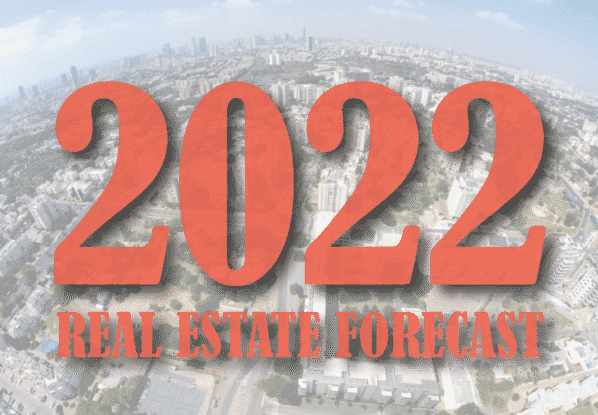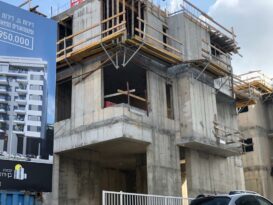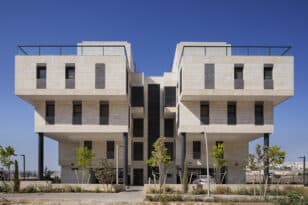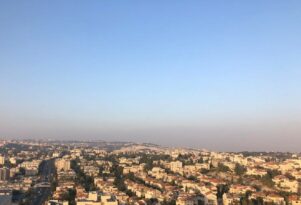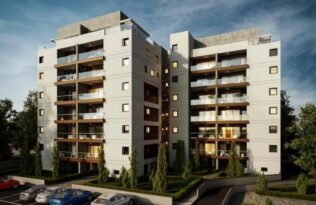After a year of record demand and sharp price increases, home prices are expected to continue into 2022, but more moderately, as urban renewal activity rapidly expands. Hadera and Modi’in are likely to see high demand, and the volume of home purchases made by Jews in the Diaspora is predicted to grow. Read more on Buyitinisrael’s forecast for the real estate market in Israel in 2022.
As 2021 draws to a close, we look back at a year that has been tough for everyone around the world. In Israel specifically, 3,000 people died this year from Covid-19, and the livelihoods of thousands of workers, mainly in the fields of recreation and tourism, were severely affected. In terms of the housing market, 2021 was particularly hard-hitting for homebuyers, who found themselves facing a market with peak demand and sharp price increases, at a rate of more than 10% throughout the year. Under such circumstances, a moment of hesitation could lead to buyers having to pay tens of thousands of shekels more. But for most Israel real estate developers, marketers, and professionals, and for mortgage banks, 2021 was a hugely successful year.
Now, as 2022 approaches, everybody is wondering what awaits us on the real estate horizon. This question is particularly intriguing given the fact that only a few weeks ago the government changed the conditions under which the market operates, approving a series of measures intended to cool the market. Will their efforts succeed? We’re certainly not prophets, but here are our predictions for the new year:
Supply: First encouraging signs after two tough years
Housing supply suffered a serious blow during the early stages of the Coronavirus pandemic. Firstly, the “land bank” in Israel – Israel Land Authority, functioned only partially for most of 2020, as was reflected in record minimum levels of land marketed for construction that year. This caused a shortage of land, felt by the entire market, with dozens of contractors competing for every piece of land marketed for development, which inevitably led to price increases. Secondly, the restrictions on the movement of people and goods created by the pandemic made it difficult for developers to build at the rate that preceded the pandemic.
According to data from the Central Bureau of Statistics, between 2020 and early 2021 there was approximately a 15% drop in the total number of new apartments for sale on the market: from 52,000 apartments in January 2020 to 44,000 in February 2021, with the amount remaining at those levels for the rest of 2021.
But after two challenging years, there are some hopeful signs: There has been an increase in the number of apartments under construction, from 54,000 in 2020 to about 58,000 this year (this is an estimate since the actual figures will not be published until March). Another encouraging sign is that the Land Authority is expected to end 2021 with State land sold for the construction of 60,000 apartments during the year – most of them after the establishment of the new government, in the second half of the year. However, much of the land sold is under the Target Price plan that requires most apartments to be built for “eligible” buyers. Since the majority of home buyers do not qualify for this scheme, they will be forced to turn to the second-hand market.
While these signs are expected to improve the situation slightly, they will not be enough to replenish the shortfall created after two years of shortages.
Demand: Decline on the part of investors and first-time buyers
2021 was a record-breaking year in demand for apartments, reflected in the number of transactions made, the volume of mortgages taken, and home prices.
A number of measures recently introduced are expected to cool down the market and reduce the demand: In October, the government increased the Purchase Tax (Mas Rechisha) rate for investors from a minimum tax bracket of 5% to 8%, which should reduce the number of transactions made for investment purposes. This tax hike applies to Israeli residents purchasing a second apartment or more, but also applies to all foreign residents purchasing a home in Israel.
Another measure introduced which is expected to affect demand is the Target Price program initiated by Minister of Construction and Housing Ze’ev Elkin, which allocates 60% of all apartments built on State land to first-time homebuyers (except in the most expensive cities such as Tel Aviv and Herzliya) at discounted prices. While this plan is expected to intensify the demand among first-time homebuyers, many will seek to purchase in order to enjoy the benefits of the plan and not necessarily out of a need. Thus, in the short term, it is expected to reduce general housing demand since many of these purchasers are expected to “disappear” from the market and wait to win one of the Target Price lotteries.
Home prices: Will continue to increase but at a more moderate pace
The huge demand, along with limited supply, led home prices to soar in 2021. For the first time since 2010, the annual rate of price increase was higher than 10%. The return of balance to the market does not occur overnight, and therefore, despite the measures taken by the government to moderate demand and increase supply, 2022 is also expected to be a year of increased prices – albeit at a more moderate rate.
Urban Renewal – An increase in activity as TAMA 38 era ends
In terms of urban renewal in Israel, all signs point to increased activity in 2022, for a number of reasons. An amendment was recently approved for Pinui-binui which applies to large buildings or complexes, reducing the required consent rate among the residents to 66% (from 80%). This will enable the advancement of dozens of projects that until now have been stuck due to the inability to reach a sufficient majority among the residents.
In addition, a severe shortage of new land has led many real estate developers that have traditionally specialized in new construction, to start operating in the field of urban renewal as well, due to the understanding that this is an area of real estate in Israel that is going to occupy a growing share of construction activity. With the increase in the number of developers in urban renewal, the volume of projects is expected to rise in 2022.
Barring any last-minute changes, TAMA 38 is expected to expire in nine months. According to the government, the program will no longer be valid from 1 October 2022, and the Shaked Alternative is expected to take its place as the main solution for the renewal of individual buildings. Here too, an increase in activity is expected with the submission of a large number of TAMA 38 requests before the deadline.
A strong factor for increased urban renewal is the high-profile event, the collapse of an old apartment building in Holon, just 24 hours after its occupants were evicted. Since the collapse, workers in the industry have reported a sharp increase in applications for TAMA 38 projects, from hundreds of residents of buildings that were previously indifferent to the issue.
Emerging areas: From Modi’in to Hadera
The Gush Dan area, which includes Tel Aviv, and Jerusalem are two of the highest-demand areas for real estate in our tiny country Israel, and will most likely remain that way in 2022. At the same time, it is worth paying attention to some interesting trends we have noticed:
One of the areas that are gaining traction is the city of Hadera, which joins the demand cycle of the central part of the country. In Israeli real estate slang, there is the longstanding phrase “Gedera to Hadera” which spans the main area that is considered sought after for residential purposes, at the center of which Tel Aviv is located. However, until recent months, the city of Hadera was considered one that indicates the border point of the demand areas but is not actually included in them, and now the trend seems to have changed – with a sharp increase in prices in the city in the past year that brought the cost of 4-room apartments from NIS 1,3500,000 to NIS 1,500,000.
Modi’in is currently building one of the largest new neighborhoods, Moreshet, with 4,000 new housing units – an amount that is considered rare when it comes to such a sought-after city as Modi’in. Another city where high-volume construction is currently being carried out is Ashkelon, but this southern city is more remote than the main areas of demand, and prices there are significantly lower.
In Gush Dan, it is worth following housing developments that the new mass transportation projects are inspiring. For example, a large number of pinui-binui projects can be seen in Bat Yam along the route of the Red Line of the light rail, which is scheduled to start operating at the end of the coming year (but is likely to start operating in 2023). Similar processes are expected to take place in Holon, along the green route of the railway (starting operations in 2027) and in Yehud, Or Yehuda, and Ramat Gan along the Purple Line route.
Diaspora Jewry – Purchase now, make Aliyah later
Since the outbreak of the COVID pandemic, we have witnessed two opposing trends related to the immigration of Jews from abroad to Israel. The first is a sharp increase in motivation to make Aliyah, due to several factors such as the willingness of companies to allow remote work, thanks to technology, allowing Jews from Europe and the United States to move to Israel while maintaining their jobs abroad. Another factor for Aliyah is the increase in antisemitic incidents that have been witnessed around the world since the beginning of the pandemic.
However, alongside the increase in motivation to get to Israel, the pandemic has also created challenges — travel between countries has become increasingly difficult, if not impossible, with the skies opening and closing intermittently. Those who wish to come to Israel for a vacation, Aliyah pilot trip, or to purchase an apartment, are hit with complicated regulations and are required to self-isolate for days, sometimes weeks, after traveling in either direction. Generally speaking, people prefer to make more complex moves where there is certainty and assurance, not something we have had in the last two years.
Professionals and real estate marketers working with foreign buyers expect to see a huge demand in the coming year due to fears that prices will continue to rise. These purchases will be made by those who are planning Aliyah, even if only in years to come, and by those who are not necessarily planning to move the center of their life to Israel but want to own property as an “insurance certificate” in case things deteriorate in their native country.
Finally, although the conditions for stalling, or falling, prices are not yet ripe, it seems that there is room for hope that after a year of wild price increases, Israel real estate prices will start to moderate in 2022. This assessment cannot be separated from the political developments, in which, after two years of chaos and uncertainty in the Israeli governmental system, a government was formed that for the first time in many years has formulated and acted on a work plan in the field of housing. While prices will likely continue on a fast track in 2022, but it appears that they’ll start to slow down along the way.
